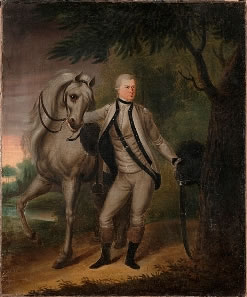
Tourism News
Myrtle Beach-area history lesson: Peter Horry
By Becky Billingsley
Horry (don't pronounce the H) County, home to Myrtle Beach and the surrounding beach communities, was named for a Revolutionary War hero whose life was illustrious but filled with frustration and self-doubt.
Peter Horry's opus, a biography of comrade in arms Francis Marion, was mangled, a major portion of his second attempt at posterity was lost, and the final insult was his age as inscribed on his grave marker is incorrect.
But at long last, 192 years after his death, in 2006 Peter Horry took his much-deserved place in the South Carolina Hall of Fame which is located in the county that bears his name.
Among the many things to do in Myrtle Beach is a tour of the Hall of Fame, located on the lower level of the Myrtle Beach Convention Center, which is at the intersection of Oak Street and 21st Avenue North. Anyone can stroll in and check it out, for free, during normal business hours.
Much of what we know about Horry is gathered in the longest written work devoted to him: A 20-page booklet by Dr. Roy Talbert, a history professor at Coastal Carolina University in Conway. His article titled “So Fine a Beach: Peter Horry’s Summer of 1812” was published as part of the school’s 1998 Distinguished Teacher-Scholar Lecture Series.
Peter Horry never lived in Horry County. He was born on March 12, 1743 (or maybe 1744), in Georgetown County, a third-generation American descended from French Huguenots. Talbert’s notes from one of Horry’s 1812 journal entries show he had three brothers (one older, two younger) and one younger sister. The Horrys were a family of rice planters and slave owners with some 1,700 acres of land south of Georgetown.
Talbert also chronicles that Horry attended a free Winyah Indigo Society school, and had an unpleasant experience as an apprentice to a Georgetown merchant.
In 1775 Horry was elected a captain – fifth in precedence out of 20 captains – by the Provincial Congress of South Carolina and assigned to the Second South Carolina Regiment. Francis Marion was ranked two slots higher, and the two captains served together. In 1776 Horry was promoted to major, and three years later he achieved the rank of lieutenant colonel with the Fifth Regiment of the Continental Army. Talbert notes at this time Horry also “held a full colonel’s commission in the state militia.”
The year 1780 was full of tumultuous change and bitter battles. Several regiments were combined in 1780, and for a time Horry was without a command. This meant although his feelings were hurt at not receiving a new command in the new organization, he luckily was not present when Charleston was surrendered to the British. Marion wasn’t there either, so neither of the old friends was captured.
“Their good fortune made Marion and Horry, and a handful of ragged guerrillas, the only force left to oppose the British in the lower half of South Carolina,” Talbert writes. This is when the stuff of legends was born, glorified in the movie “The Patriot.” The men haunted the swamps, ambushing British soldiers and then disappearing into the Lowcountry.
Anecdotes about Horry during this time may be loosely based on facts. The hero related the stories himself, Talbert explains, but the actual papers have disappeared. Horry did show the manuscript to some people, and it is their recollections, handed down word-of-mouth and most likely embellished, that survive.
One story goes that his men often called him “Stuttering Pete,” in an affectionate way. An excerpt in the 1830 book, “American Military Biography,” related by the late Catherine Lewis in her “Horry County, South Carolina, 1730-1993,” says “Colonel Horry was once ordered to await the approach of a British detachment in ambuscade, a service which he performed with such skill that he had them completely within his power; when, from a dreadful impediment in his speech, by which he was afflicted, he could not articulate the word ‘fire.’ In vain he made the attempt – it was fi-fi-fi-fi – but he could get no further.
“At length, irritated almost to madness, he exclaimed, ‘Shoot, damn you, shoot—you know very well what I would say—shoot, shoot, and be damned to you!’”
Other tales related by Talbert say Horry was a better swordsman than horseman, and once ended up unseated, yelling for help and hanging from a tree branch. Another time his men became too drunk to fight, and he had to turn around and take them back to camp. During this period he fought hard, was wounded several times, endured illness and took over command of the Swamp Fox Brigade when Marion was away.
But in 1781, after so much dedicated and grueling service, Horry suffered a conflict with another officer that tested his friendship with Marion. That year he was named “Lieutenant Colonel Commandant of a Battalion of Light Dragoons for the State of South Carolina, to be employed in the Service of America.”
Problem was, an officer named Hezikiah Maham received the same rank of an identical second unit, and the two men did not get along. Horry had seniority over Maham, which Maham refused to acknowledge.
Horry complained much to Marion and to the commander of the Southern Army, General Nathanael Greene. The feud worsened, Talbert writes, when Marion left in 1782 to attend a state senate meeting. The ordeal ended when the two units were combined, with Maham given command. Peter Horry received command of Georgetown, an assignment that lasted about two months before Marion relieved Horry of his final command of the American Revolution.
But soon after the war ended, the old friends made up. They both served in the state militia, and finally, in the mid-1790s, Peter Horry achieved the rank of Brigadier General. He served his state and his country until retirement in 1806.
Francis Marion died in 1795, and afterward Horry organized from various papers and letters a biography of his old friend. He allowed Mason Locke “Parson” Weems, a writer and Episcopalian minister who enjoyed romanticizing history, to prepare the documents as a manuscript. This is the same Weems who had earlier concocted lies about George Washington, including the infamous and false cherry tree-chopping /“I can not tell a lie” story.
The resulting biography, “The Life of General Francis Marion,” was a travesty. In an article for the April 1937 issue of South Carolina Historical and Genealogical Magazine, A.S. Salley wrote, “Weems changed most of the statements from truth to falsehoods, invented and inserted many things that had never happened and called it a life of Marion. Very little of the actual career of Marion is recorded therein. Horry’s annotated copy is extant and it shows many of Weems’ false statements, but not near all. To Horry Weems acknowledged that he had written a ‘military romance.’ The title page of the first edition credits the alleged biography to Weems, but after Horry’s death new editions falsely assigned it to Weems and Horry, despite Horry’s repeated repudiation of it during his lifetime.”
Peter Horry spent his post-military years at his home south of Georgetown and summered at a beach house on North Island. He married late in life, in 1793 at about age 49. He and his wife, Magdalen Guignard of a wealthy Columbia family, had no children.
Horry was alive to take his place in history when Horry County was named in his honor in 1801. Three years earlier, the adjoining county was named for his old friend, Francis Marion.
Horry’s final years took place at a farmhouse outside Columbia. Before he died on Feb. 28, 1815, (at age 71 or 72; not age 68 as his grave marker indicates) he added to the extensive 1812 journal entries that provide the best glimpses into his life.
“He was a neglected and fascinating man,” Talbert said in 2006. “He was a frustrated author…He tried to get his war book published and failed, then he gave it to Weems and he messed it up. He did the journal, and one of the last things in his journals was he wanted to get it published, but it hasn’t been.
“He was fascinating because his claim to fame was he was there when Francis Marion needed him…and because he is Francis Marion’s biographer.
“He felt very neglected in his old age, and he would be really pleased to be … in the South Carolina Hall of Fame.”


